Published
- 17 min read
Understanding Cloud-Based PaaS: A Comprehensive Guide

Key Highlights
- Cloud based PaaS gives you everything you need to build apps, so that you don’t need to manage the underlying infrastructure.
- In this cloud computing model, you can use development tools, operating systems, and cloud services when you want. This helps people bring apps to the market faster.
- The best things about PaaS are that you save a lot of money, get better safety, and it can grow or shrink to fit your needs any time.
- PaaS is different from IaaS or SaaS. It is made for people making software and lets developers work on code more freely.
- Today, modern platforms like Kuberns are using AI to make app deployment and management faster, reliable and more affordable.
Introduction
In the world of cloud computing, picking the right service model is very important for a business to do well. As companies stop using traditional on-premises solutions, they have to find a cloud platform that is flexible and can get work done fast and efficiently.
Managing your own IT infrastructure is not just complex, but not cost-effective as well. This is where Platform as a Service (PaaS) comes in as a powerful alternative. It gives developers an easy space to build, deploy, and manage web apps without getting stuck in the hard parts of the backend.
What is Cloud-Based PaaS?
Platform as a Service (PaaS) is a type of cloud computing model that gives you a ready-made development platform over the internet. You do not have to build or maintain your own infrastructure. Instead, a third-party service provider takes care of the hardware, software, and development tools for you. This way, your team can focus on writing code and building applications.
These cloud services are are delivered on-demand, creating efficient cloud environments for development. The provider takes care of every part of the platform. This includes the servers, operating systems, network, and storage. Your developers get a strong toolkit and they do not need to deal with traditional setup costs or maintenance headaches.
Defining Platform as a Service in the Cloud Era
Platform as a Service gives you a full cloud setup that has everything development teams need to create, run, and manage an app. You get servers, operating systems, networking, storage, middleware, and development tools. This way, you have all the things you need in one package. It helps teams bring their applications to life.
The main idea of this service model is to hide abstract away the underlying infrastructure. The cloud provider hosts and manages all the backend components at their data center. This means your development team does not need to deal with system administration, software updates, and hardware maintenance.
So, your team can be more agile and productive. They just use the platform, provision the resources they need, and begin their work right away. This helps developers focus on new ideas and their code. They do not need to be concerned about the platform it runs on.
A platform like Kuberns gives people all the tools they need in one integrated environment for the best experience.
How Cloud Based PaaS Works
A cloud-based PaaS solution works when a service provider hosts the entire development stack and deliver it to you over the internet. This stack typically includes cloud infrastructure like servers and storage, middleware software such as operating systems and frameworks, and a user interface. Developers can get access to this platform by using a graphical user interface (GUI), a command-line interface (CLI), or an API.
The provider takes care of the underlying infrastructure. They make sure that everything is safe, secure and up to date. This helps you run things on the cloud without worry.
With this, you can build apps directly on the PaaS. After you finish your app, you can launch it at once. You do not need to do anything more to configure the environment.
This way makes it much easier to manage your app. Your team can work together from anywhere with as long as there is internet connection, working together in a shared environment. The platform takes care of the hard parts, from server maintenance to runtime management and your developers can focus more on building new, better and innovative software.
Key Benefits of Cloud Based PaaS for Businesses
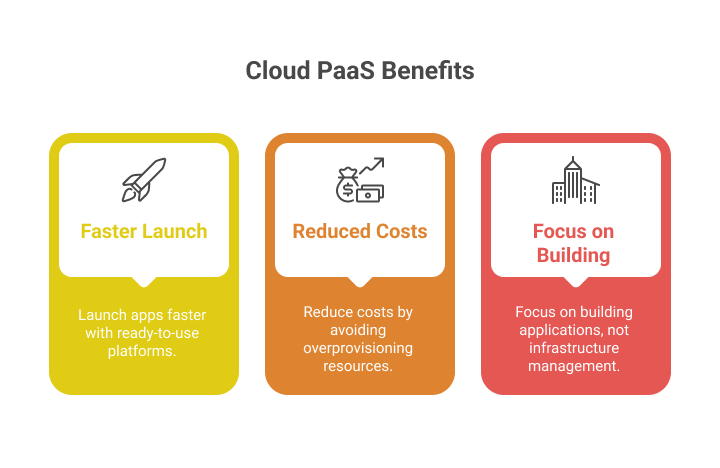 The benefits of PaaS help businesses big and small. One good thing is how it lets you get your product out faster. PaaS gives you a platform that’s ready to use. By providing a pre-built platform, PaaS eliminates the delays associated with setting up and configuring your own cloud infrastructure. This way, your development team can start building as soon as they want.
The benefits of PaaS help businesses big and small. One good thing is how it lets you get your product out faster. PaaS gives you a platform that’s ready to use. By providing a pre-built platform, PaaS eliminates the delays associated with setting up and configuring your own cloud infrastructure. This way, your development team can start building as soon as they want.
Also, PaaS helps you use your resources in the best way possible. You can set up your resources to fit your business, so you do not spend money on things you do not need and avoid the costs of overprovisioning. A provider takes care of the platform for you, so your teams can work on important projects and do not have to deal with day-to-day upkeep.
The next parts will look at how PaaS helps you save money and grow.
Cost Savings and Resource Optimization
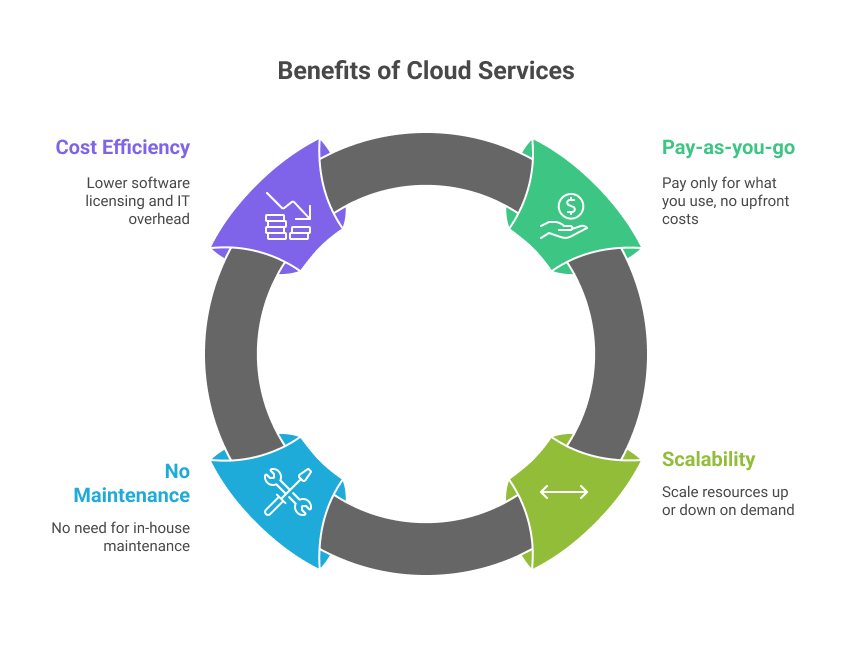 Switching to a PaaS model helps save a lot of money by changing the way you how you acquire and use IT infrastructure. Instead of spending a lot of money at the start on things like hardware and software licenses, you can pay for what you use as you go. It lets you pay only for the software resources you use, so your costs are easier to plan for and control over time.
Switching to a PaaS model helps save a lot of money by changing the way you how you acquire and use IT infrastructure. Instead of spending a lot of money at the start on things like hardware and software licenses, you can pay for what you use as you go. It lets you pay only for the software resources you use, so your costs are easier to plan for and control over time.
This way of managing your resources makes sure you do not spend money on things you do not need. If you use Traditional on-premises setups, you have to buy enough hardware to handle peak traffic. Most of the time, a lot of it is not even used. With PaaS, you can scale resources up or down on demand, This means you pay for what you use.
PaaS further helps to cut costs by taking away the need for in-house management of the platform. The provider will handle all updates, fixes, and maintenance for the platform, so your overall application management costs go down. This lets you:
- Stay away from capital equipment expenses.
- Reduce or eliminate software licensing fees.
- Get advanced development tools without spending too much.
- Bring down your overall IT operational overhead.
Scalability and Flexibility with Kuberns
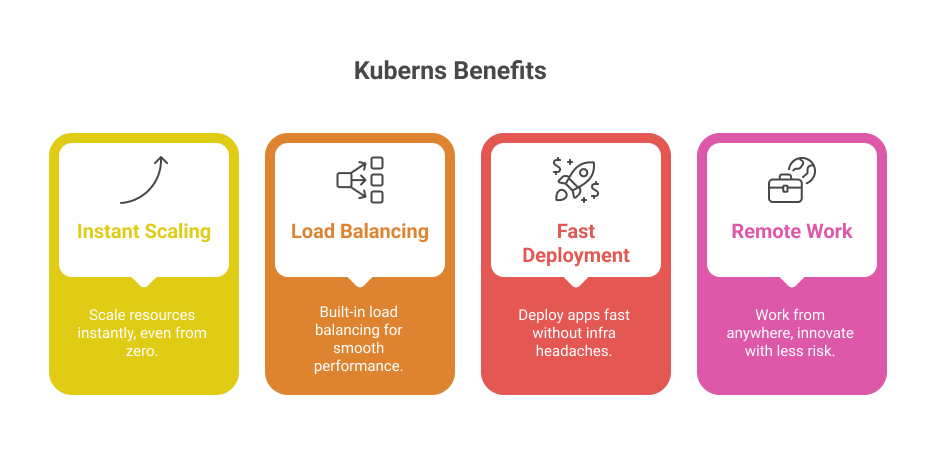 The main benefits of using cloud-based PaaS are scalability and flexibility. Platforms like Kuberns help you get the most out of these features. A traditional setup can struggle, especially when there is a sudden jump in traffic. With PaaS, you can scale your resources Instantly, making sure your web app remains responsive and available without manual intervention.
The main benefits of using cloud-based PaaS are scalability and flexibility. Platforms like Kuberns help you get the most out of these features. A traditional setup can struggle, especially when there is a sudden jump in traffic. With PaaS, you can scale your resources Instantly, making sure your web app remains responsive and available without manual intervention.
This flexibility also helps work as well. Your teams can access the platform and its cloud services from anywhere. This lets people work together and helps with remote work. Your teams can experiment with new technologies and frameworks without committing to expensive infrastructure. This gives them more room to innovate with less risk.
Kuberns.com takes this a step further by offering an AI-powered platform that simplifies deployment and scaling.
With Kuberns, you can:
- Automatically scale resources up or down, even from zero, based on traffic.
- There is built-in load balancing to to distribute traffic efficiently.
- You can deploy your containerized applications fast and you do not have to worry about handling infrastructure.
Comparing Cloud Based PaaS, SaaS, and IaaS
Understanding the differences between IaaS, PaaS, and SaaS is key to selecting the right cloud platform for your needs. These three service models represent the main categories of cloud computing, each offering a different level of management from the provider. What the provider handles and what you get to manage are not the same in each model.
IaaS (Infrastructure as a Service) provides the basic building blocks, SaaS (Software as a Service) delivers a complete application, and PaaS sits in the middle. PaaS offers a platform for you to build your own applications, managing more of the stack than IaaS but giving you more control than SaaS. Let’s examine these differences more closely.
Core Differences Between the Three Service Models
Each cloud service model gives you a unique level of control and responsibility over your setup and work. With IaaS, the cloud provider takes care of the physical infrastructure, like servers and networks. But you must look after the operating system, middleware, and applications. It’s like when you rent a piece of land and build your house on it, from start to finish.
A PaaS solution does more. The provider takes care of the infrastructure and development platform. This includes the operating system and middleware. You get to focus only on software development and managing your application and its data. This is like renting a fully furnished house, you just need to bring your personal belongings.
SaaS gives you a full, ready-to-use application over the internet. The provider takes care of all parts, from underlying hardware to the application itself. You just use the software. It is like staying in a hotel, where they handle everything for you. Platforms like Kuberns bring you a helpful and powerful PaaS solution, so giving you the perfect balance for custom development.
| You Manage | IaaS (Infrastructure) | PaaS (Platform) | SaaS (Software) |
|---|---|---|---|
| Applications | Yes | Yes | No (Managed by provider) |
| Data | Yes | Yes | No (Managed by provider) |
| Runtime & Middleware | Yes | No (Managed by provider) | No (Managed by provider) |
| Operating Systems | Yes | No (Managed by provider) | No (Managed by provider) |
| Servers, Storage, Networking | No (Managed by provider) | No (Managed by provider) | No (Managed by provider) |
When to Choose PaaS Over SaaS or IaaS?
The right model for you will depend on what your business needs. If you want to build, test, and deploy custom applications quickly and efficiently, PaaS is a good choice. A PaaS application platform lets your team focus on coding. You do not have to worry about infrastructure management.
You should choose IaaS when you need maximum control over your environment. This way, you can make something from the ground up that fits just what you want. This model is suitable for IT operations teams that want to build a highly customized infrastructure from scratch.
On the other hand, SaaS is better when you just want software that works right away. If you see a SaaS product that does what you want and you do not need to change it, it is often the simplest choice.
However, for most development projects, PaaS is often the best choice. It helps speed up development and cuts down on extra work. This can make it better than IaaS when you build new apps. Unlike the rigid offerings from many SaaS vendors, a PaaS like Kuberns.com gives you the freedom to create software tailored to your unique requirements.
Common Use Cases and Application Types
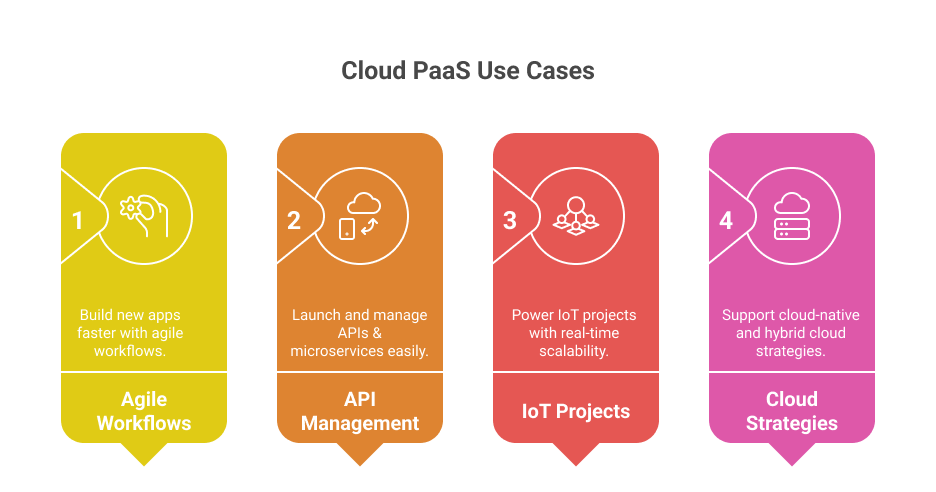 PaaS can be used for many things and works well for wide range of use cases and application types. It gives you a strong base to build new apps, set up APIs, and microservices to supporting agile and DevOps workflows. PaaS makes it easier to build and manage apps, so it becomes a go-to choice for teams looking to innovate faster.
PaaS can be used for many things and works well for wide range of use cases and application types. It gives you a strong base to build new apps, set up APIs, and microservices to supporting agile and DevOps workflows. PaaS makes it easier to build and manage apps, so it becomes a go-to choice for teams looking to innovate faster.
PaaS works great for projects about the Internet of Things (IoT). It helps handle real-time data and can scale up, which is important for these jobs. It is also good for cloud-native development and supports hybrid cloud strategies seamlessly. The next sections will talk in detail about the best use cases for PaaS and how different fields use it.
Best-Fit Applications for Cloud PaaS Solutions
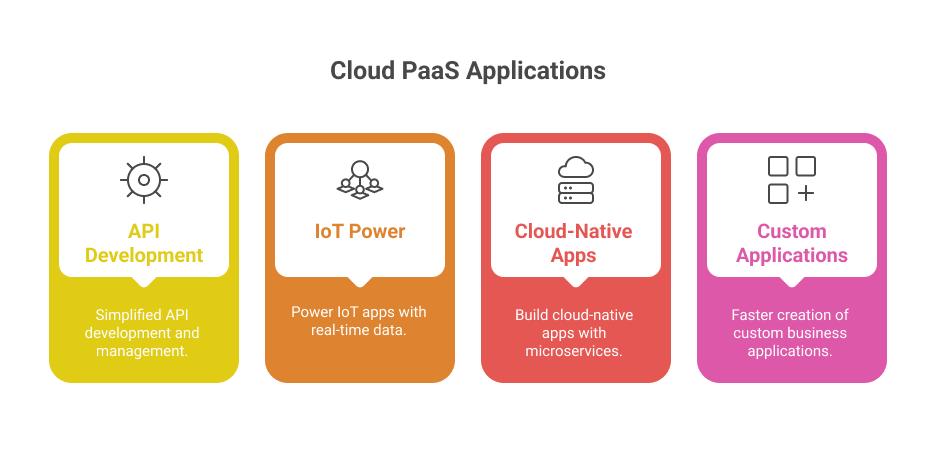 PaaS platforms are built to help you with every part of creating new apps. This makes them a top choice for many development projects. The integrated setup and pre-configured tools make app development easier allowing teams to deliver custom applications with greater speed and efficiency.
PaaS platforms are built to help you with every part of creating new apps. This makes them a top choice for many development projects. The integrated setup and pre-configured tools make app development easier allowing teams to deliver custom applications with greater speed and efficiency.
Some of the best-fit uses for PaaS are where you need to make changes often and release updates fast. The platform lets teams use built-in for continuous integration and continuous delivery (CI/CD) automates the software pipeline, which is essential for agile development teams. This way, development teams can do their jobs in a smart and flexible way. PaaS is a good choice for making and running today’s software that can grow with your needs.
Specifically, PaaS solutions are ideal for:
- API Development and Management: PaaS makes it easy to build, run, and keep APIs safe. You can use it to connect different services.
- Internet of Things (IoT): PaaS can handle the large amount of data from IoT devices. It also supports multiple programming languages for IoT app development.
- Cloud-Native Applications: PaaS is a good choice for building new apps using modern architectures like microservices and containers.
- Custom Business Applications: It lets you make software that fits your business needs.
Security Considerations for Cloud Based PaaS
When you start using any cloud service, security is very important. If you use PaaS, both you and the cloud provider have a shared responsibility in keeping things safe. The provider is responsible for securing the core platform, including the infrastructure, network, and operating systems. There is a strong level of safety and security that would be difficult and expensive to achieve on your own.
You still have to keep your application and the data it processes secure. You need to handle managing user access, configuring application-level security settings, and ensuring compliance with industry regulations. If you understand how this shared model works, you can lower risk and use the platform’s security tools effectively.
Leveraging AI Capabilities in Modern PaaS
The next step for cloud-based PaaS is to bring in Artificial Intelligence (AI) and Machine Learning (ML). Now, these platforms are not just static environments for development. They are turning into intelligent systems that can make things better, save time, and secure the entire application lifecycle. These AI features are changing what you can do with PaaS.
By using AI, PaaS providers can give us features like predictive scaling, automated bug detection, and smart management of resources. This helps make performance better and lets developers spend more time on innovation.
As we go forward, platforms like Kuberns are at the front, building the next generation of AI-powered PaaS.
How Kuberns Utilizes AI for Next-Gen PaaS?
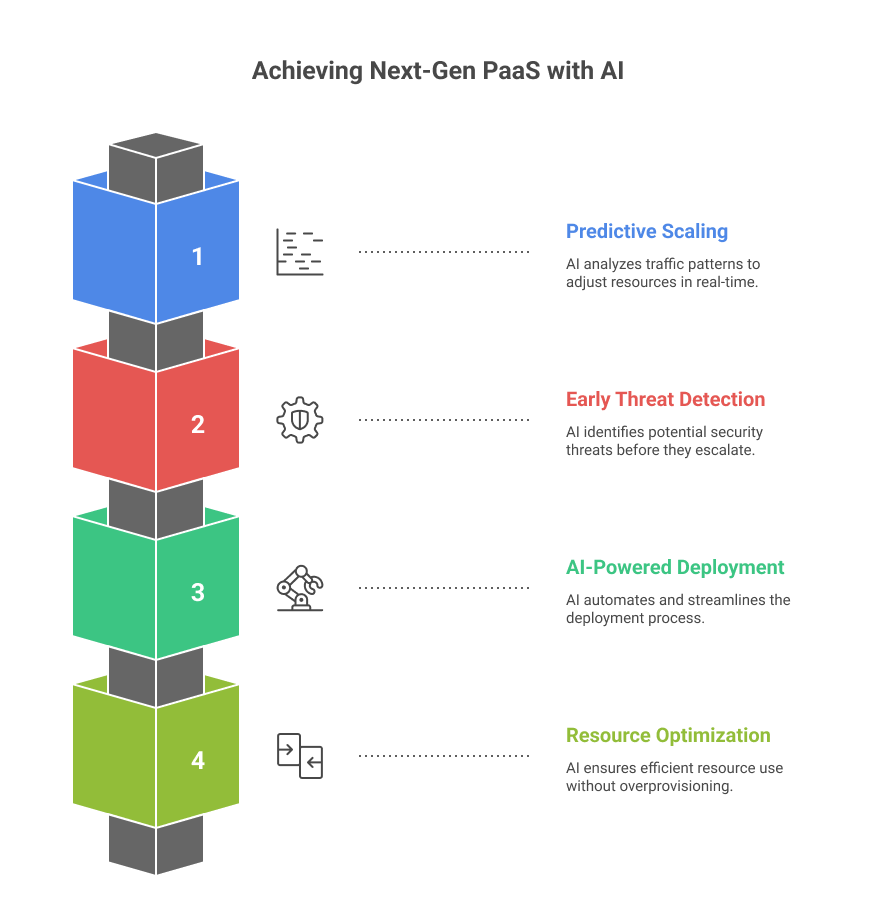 Kuberns is leading the move to a new kind of PaaS with Artificial Intelligence at its core. The platform uses top Machine Learning tools to help speed things up and make each part of development better. This means work gets done faster and in a smart way.
Kuberns is leading the move to a new kind of PaaS with Artificial Intelligence at its core. The platform uses top Machine Learning tools to help speed things up and make each part of development better. This means work gets done faster and in a smart way.
With us, you get more than just a PaaS. You get a PaaS that thinks for you.
Our AI powered engine looks at how you use resources in real-time to provide predictive scaling, ensuring your application always has the resources it needs without overprovisioning. You will not get too many or too few resources.
The system also helps to make security checks easy. It finds problems and threats early. This means your services stay safe, before anything bad can happen. Kuberns works this way, which makes it different from other PaaS options.
With Kuberns, you get more than a platform. You get a smart partner to help you. We use AI to make Complex tasks easy, like deployment, management, security, and optimization of your software. This helps your team build better software faster. You can feel sure because our strong AI is always working in the background, making sure everything runs well.
Conclusion
In conclusion, understanding cloud-based PaaS is essential for businesses looking to streamline their operations and take advantage of cutting-edge technology.
The flexibility and scalability offered by Kuberns allow organisations to optimise their resources and enhance productivity. By leveraging AI capabilities, Kuberns provides a powerful solution that not only meets but exceeds the demands of modern application deployment.
The benefits of adopting a PaaS model are numerous, from cost savings to enhanced security. If you’re ready to elevate your business with an AI-powered PaaS platform, don’t hesitate to explore what Kuberns has to offer.
Get a free consultation today to see how we can empower your organization!

Frequently Asked Questions
Is cloud based PaaS suitable for startups and enterprises?
Yes, cloud based PaaS works well for both startups and big companies. With its ability to grow as you need, startups can begin small without large upfront costs. enterprises can use it to speed up development cycles and make their apps fit better according to their business needs.
How can developers deploy and scale apps using Kuberns.com?
With Kuberns.com, developers can deploy and scale apps effortlessly. The platform uses AI to automate containerized deployments in seconds. It manages scaling on its own, based on real-time traffic to adjust the number of resources your application uses, so you do not have to do any extra work. This way, your team can be sure the app has what it needs at all times.
What are the key challenges when shifting to a cloud based PaaS?
The main problems you can face when you move to a cloud-based PaaS are getting stuck with one provider, keeping your data safe, and ensuring data security and compliance with industry regulations. You also have to make sure the new platform works well with existing on-premises systems. To handle these risks, you need to plan well and think ahead.
Citations: [1] Statista. (2024). Platform as a Service - Worldwide. Retrieved from https://www.statista.com/outlook/tmo/public-cloud/platform-as-a-service/worldwide